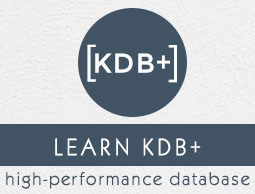
- KDB+ Tutorial
- KDB+ - Home
- KDB+ Architecture
- KDB+ - Overview
- KDB+ - Architecture
- Q Programming Language
- Q Programming Language
- Q Language - Type Casting
- Q Language - Temporal Data
- Q Language - Lists
- Q Language - Indexing
- Q Language - Dictionaries
- Q Language - Table
- Q Language - Verb & Adverbs
- Q Language - Joins
- Q Language - Functions
- Q Language - Built-in Functions
- Q Language - Queries
- Q - Inter-Process Communication
- Q - Message Handler (.Z Library)
- Q Advanced Topics
- Q Language - Attributes
- Q Language - Functional Queries
- Q Language - Table Arithmetic
- Q Language - Tables on Disk
- Q Language - Maintenance Functions
- KDB+ Useful Resources
- KDB+ - Quick Guide
- KDB+ - Useful Resources
- KDB+ - Discussion
Q Language - Indexing
A list is ordered from left to right by the position of its items. The offset of an item from the beginning of the list is called its index. Thus, the first item has an index 0, the second item (if there is one) has an index 1, etc. A list of count n has index domain from 0 to n–1.
Index Notation
Given a list L, the item at index i is accessed by L[i]. Retrieving an item by its index is called item indexing. For example,
q)L:(99;98.7e;`b;`abc;"z") q)L[0] 99 q)L[1] 98.7e q)L[4] "z
Indexed Assignment
Items in a list can also be assigned via item indexing. Thus,
q)L1:9 8 7
q)L1[2]:66 / Indexed assignment into a simple list
/ enforces strict type matching.
q)L1
9 8 66
Lists from Variables
q)l1:(9;8;40;200) q)l2:(1 4 3; `abc`xyz) q)l:(l1;l2) / combining the two list l1 and l2 q)l 9 8 40 200 (1 4 3;`abc`xyz)
Joining Lists
The most common operation on two lists is to join them together to form a larger list. More precisely, the join operator (,) appends its right operand to the end of the left operand and returns the result. It accepts an atom in either argument.
q)1,2 3 4
1 2 3 4
q)1 2 3, 4.4 5.6 / If the arguments are not of uniform type,
/ the result is a general list.
1
2
3
4.4
5.6
Nesting
Data complexity is built by using lists as items of lists.
Depth
The number of levels of nesting for a list is called its depth. Atoms have a depth of 0 and simple lists have a depth of 1.
q)l1:(9;8;(99;88)) q)count l1 3
Here is a list of depth 3 having two items −
q)l5 9 (90;180;900 1800 2700 3600) q)count l5 2 q)count l5[1] 3
Indexing at Depth
It is possible to index directly into the items of a nested list.
Repeated Item Indexing
Retrieving an item via a single index always retrieves an uppermost item from a nested list.
q)L:(1;(100;200;(300;400;500;600))) q)L[0] 1 q)L[1] 100 200 300 400 500 600
Since the result L[1] is itself a list, we can retrieve its elements using a single index.
q)L[1][2] 300 400 500 600
We can repeat single indexing once more to retrieve an item from the innermost nested list.
q)L[1][2][0] 300
You can read this as,
Get the item at index 1 from L, and from it retrieve the item at index 2, and from it retrieve the item at index 0.
Notation for Indexing at Depth
There is an alternate notation for repeated indexing into the constituents of a nested list. The last retrieval can also be written as,
q)L[1;2;0] 300
Assignment via index also works at depth.
q)L[1;2;1]:900 q)L 1 (100;200;300 900 500 600)
Elided Indices
Eliding Indices for a General List
q)L:((1 2 3; 4 5 6 7); (`a`b`c;`d`e`f`g;`0`1`2);("good";"morning"))
q)L
(1 2 3;4 5 6 7)
(`a`b`c;`d`e`f`g;`0`1`2)
("good";"morning")
q)L[;1;]
4 5 6 7
`d`e`f`g
"morning"
q)L[;;2]
3 6
`c`f`2
"or"
Interpret L[;1;] as,
Retrieve all items in the second position of each list at the top level.
Interpret L[;;2] as,
Retrieve the items in the third position for each list at the second level.